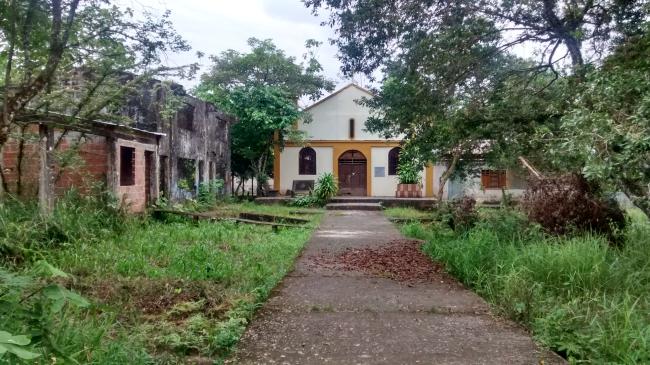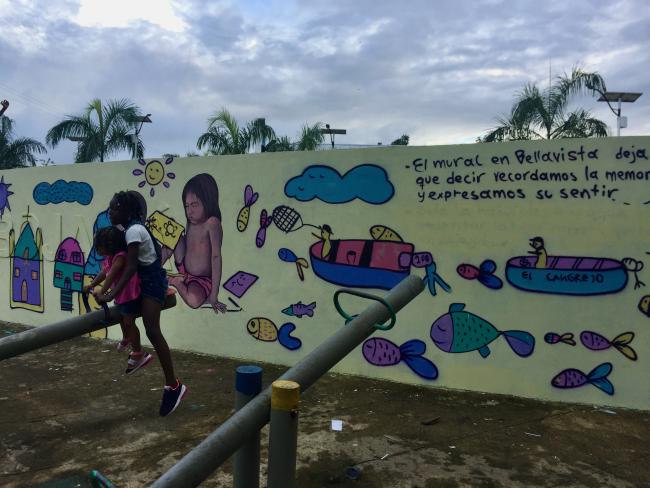
“Bojayá’s dead are our dead,” reads the banner on the commemorative website maintained by the Comité por los Derechos de las Víctimas de Bojayá (Committee for the Rights of the victims of Bojayá), representing the municipality of Bojayá in Colombia’s northwestern department of Chocó. On May 2, the community commemorated the 21st anniversary of a massacre that killed around 100 people and left the displaced survivors searching for closure and justice. It is a wait that continues today.
The commemorative site is an important tool in the process of healing and resolution. Through historical education, community organizing, and advocacy for culturally relevant justice, the Comité uses its website to uplift the voices of the survivors of one of the most infamous atrocities of Colombia’s modern conflict and preserve the memory of those that were lost.
The modern civil war forced the people living in Colombia’s department of Chocó into an especially precarious situation. It was a multipolar conflict, involving the national government, left-wing guerrillas like the Revolutionary Armed Forces of Colombia (FARC), and right-wing paramilitaries like the United Self-Defense Forces of Colombia (AUC). The boundaries between these factions were never set in stone. Allegiances and ceasefires were made and broken quickly as across the nation armed groups jockeyed for any advantage over their enemies. The government killed peasants and dressed their corpses up like guerrillas to inflate official body counts. The FARC guerrillas kidnapped children and forced them to fight in their units. The AUC paramilitaries massacred community leaders, activists, and civilians. Regardless of which armed force moved through an area, it was local people who suffered.
Chocó was—and continues to be—an especially precarious department for residents because it borders both the Pacific Ocean and the Caribbean Sea. For the guerrillas and paramilitaries, access to both coasts made Chocó crucial territory for the drug smuggling operations necessary to finance their military activities. In the late 1990s and early 2000s, the guerrillas and paramilitaries battled each other in the region, in an escalating campaign of terror and atrocity. The violence heavily impacted the predominantly Afro-Colombian population of Chocó, adding to centuries of marginalization.
On the morning of May 2, 2002, the municipality of Bojayá on the Atrato River became the site of a battle between FARC guerrillas and AUC paramilitaries. The paramilitaries had entered the town of Bellavista the day before, and refused to move on when local residents begged them to leave. Instead, they occupied the town, dug in, and waited for the guerrillas to arrive. When the FARC appeared and the two groups exchanged fire, the people of Bellavista took shelter in the town's church. As the firefight dragged on, the guerrillas set up a mortar and launched a gas cylinder pipe bomb at the paramilitaries, who were using Bellavista’s church as a shield. The bomb missed its target and crashed through the roof of the church, landing on the altar. The crucifix behind the altar sustained serious damage in the explosion and became a symbol of Colombia’s civil war, known as the “Mutilated Christ of Bojayá.” The death toll is uncertain, but the Special Jurisdiction for Peace (JEP) reports that over 102 people were killed, many of them women and children. The Comité por los Derechos de las Víctimas de Bojayá confirms that number on its website and names 81 victims and one unidentified child.
The Bojayá Massacre, as the attack became known, displaced 5,771 people who survived the gunfight in the town and explosion in the church, according to Colombia’s National Center of Historical Memory. The Colombian government pledged its support and promised to rebuild the town and resettle the survivors. In 2007, then-president Álvaro Uribe presided over the unveiling of the new town of Bellavista, four kilometers south of the original site. “The armed forces are not going to abandon this piece of Colombia,” he vowed.
The inhabitants had their own weary mantra in response: “Se verá,” or loosely translated, "We'll see."
Their jaded suspicion was prescient. Uribe promised that, within the year, electricity and power would be installed in the new town. As of last year, 15 years after his 2007 visit and three presidential elections later, the town was still waiting on the Colombian government to make good on its promise. The investments that the government has made are often out of touch with the community’s needs and way of life. As journalist Camilo Alzate pointed out on the 20th anniversary of the massacre, a grid of paved streets doesn’t make sense for a town that can only be reached by river or helicopter, and brick houses built far from the Atrato River “break the vital connection with the water, around which almost all the activities of daily life revolve.”
This year, Leyner Palacios, Bojayá survivor and former member of the Truth Commission, said that “the reparation has not been adequate for us, and in Bojayá we still have 169 people injured from that massacre who, even today, have not been attended to like they should be.”

In 2017, the Mutilated Christ of Bojayá was moved over 250 miles away to Villavicencio, the capital of the department of Meta, so that Pope Francis could pray before “the Black Christ of Bojayá.” The symbol, powerful though it is, seems to have gotten more attention than the residents and survivors who are still seeking justice.
In 2015, the FARC was the first group to acknowledge their responsibility for the massacre and to ask for forgiveness: “A forgiveness that not all of the victims are disposed to grant,” notes Alzate. “What the victims still await,” he writes, “is that the whole truth be told.”
The survivors themselves are the most equipped to tell that truth. The Comité por los Derechos de las Víctimas provides a platform for them to do so on its website. The site was built in collaboration with researchers from Universidad de Antioquia and the University of British Columbia, among other contributors. It emphasizes a philosophy of contar desde adentro, or “telling from within.” Telling from within means not only an urgency to construct and reclaim one’s own narrative,” states the site, “but also an effort to watch over and care for that information.”
In May 2017, a journalist accused the community of censoring the press when the Comité restricted journalistic access to their exhumations. Leyner Palacios said at the time that the community merely wanted the press to communicate their story “in an appropriate manner.” “We do not want [the story] that comes out to be about the bones of our relatives,” said Palacios, “but about the life stories there, about the relatives that we lost who had dreams, life goals, a dignified history to tell.”
The Comité preserves and recounts its truth by presenting its own historical account of the events surrounding the Bojayá Massacre. An interactive timeline provides context going back to the 1980s, emphasizing not only the 2002 massacre, but also the community’s subsequent efforts to reclaim their home and recover the remains of their loved ones. Furthermore, it highlights the continued challenges that the community of Bellavista confronted in the years after the massacre: additional threats and armed attacks, as well as the aforementioned tensions with the press over access to their community. In 2017 the Comité released a “Protocolo para el manejo de comunicaciones en el marco de los acuerdos del proceso de paz para Bojayá” (Protocol for handling communications in the framework of the agreements for the peace process for Bojayá), which lays out the community’s explicit preferences for how the press should engage with the community and relay its story, using the Comité as a primary point of contact and mediator.
Documentation is one important medium for the community to remember their loved ones. The Comité’s website also displays a telón, or commemorative backcloth, listing 84 names of the fallen. “Through rivers and through jungles that guard the memory of so many Black pueblos who make history here” reads a banner at the bottom. Forty-two women of the Artesanías Guayacán group embroidered the names of close relatives, families, or neighbors lost in the massacre, reports the Archivo Digital de Textiles Testimoniales.
It was only in 2019 that forensic evidence helped identify the remains of some of the victims so they could be brought home for a proper burial. When El Espectador ran an article referring to an unidentified child’s coffin as “The child from Bojayá for whom no relative wept,” the community was rightfully insulted. “That was catastrophic,” explained Yúber Palacios Córdoba, one of the Comité’s leaders. “These are stories that are told [about us] that are not true.” Bojayá’s philosophy of “telling from within” helps push back against oversimplified news coverage. One initiative developed by the Comité is to work with youth in the community to collect and organize documentary and archival materials as a form of inter-generational memory and knowledge formation.
The exhumations and identifications opened up old wounds, but also helped to bring closure for some community members. In Afro-Colombian communities on the Pacific coast, death “is lived as a journey, a passage involving the living and the dead” that embraces “an adequate farewell and establishes new relations with that loved one who will always be present as an ancestor in the life of future generations.” The process of exhumation and proper burial—something the community was not able to carry out in the aftermath of the massacre—is one important step in that journey.
Twenty-one years after the 2002 massacre, the “inhabitants of Bojayá are in permanent mourning.” But they are also taking important steps to document their experiences on their own terms, showing how memory can be used as a tool to both stay connected to loved ones and advocate for justice. It is through that process of remembering and retelling that the community can begin to heal.
Marlon Londoño is a PhD candidate in History at the University of North Carolina at Chapel Hill, currently conducting research in Bogotá on a Fulbright-Hays Doctoral Dissertation Research Abroad award.

